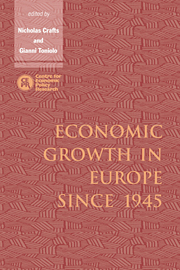Book contents
- Frontmatter
- Contents
- List of figures
- List of tables
- Preface
- List of contributors
- 1 Postwar growth: an overview
- 2 Institutions and economic growth: Europe after World War II
- 3 The varieties of Eurosclerosis: the rise and decline of nations since 1982
- 4 Why the 1950s and not the 1920s? Olsonian and non-Olsonian interpretations of two decades of German economic history
- 5 Convergence, competitiveness and the exchange rate
- 6 British economic growth since 1945: relative economic decline … and renaissance?
- 7 Economic growth in postwar Belgium
- 8 France, 1945–92
- 9 Economic growth and the Swedish model
- 10 Characteristics of economic growth in the Netherlands during the postwar period
- 11 Portuguese postwar growth: a global approach
- 12 Growth and macroeconomic performance in Spain, 1939–93
- 13 Irish economic growth, 1945–88
- 14 Italy
- 15 West German growth and institutions, 1945–90
- 16 An exercise in futility: East German economic growth and decline, 1945–89
- 17 Postwar growth of the Danish economy
- 18 Reflections on the country studies
- Index
17 - Postwar growth of the Danish economy
Published online by Cambridge University Press: 04 August 2010
- Frontmatter
- Contents
- List of figures
- List of tables
- Preface
- List of contributors
- 1 Postwar growth: an overview
- 2 Institutions and economic growth: Europe after World War II
- 3 The varieties of Eurosclerosis: the rise and decline of nations since 1982
- 4 Why the 1950s and not the 1920s? Olsonian and non-Olsonian interpretations of two decades of German economic history
- 5 Convergence, competitiveness and the exchange rate
- 6 British economic growth since 1945: relative economic decline … and renaissance?
- 7 Economic growth in postwar Belgium
- 8 France, 1945–92
- 9 Economic growth and the Swedish model
- 10 Characteristics of economic growth in the Netherlands during the postwar period
- 11 Portuguese postwar growth: a global approach
- 12 Growth and macroeconomic performance in Spain, 1939–93
- 13 Irish economic growth, 1945–88
- 14 Italy
- 15 West German growth and institutions, 1945–90
- 16 An exercise in futility: East German economic growth and decline, 1945–89
- 17 Postwar growth of the Danish economy
- 18 Reflections on the country studies
- Index
Summary
Introduction
The aggregate growth of the Danish economy since the Second World War has followed the same broad pattern as experienced in most other European countries. The overall growth of the period has been close to the average of the European OECD countries, but the profile of growth has been somewhat different. The ‘Golden Age’ of high growth and extremely low unemployment began later in Denmark than in the rest of Western Europe. During most of the 1950s, growth remained below the OECD average. The golden period began in the late 1950s and ended in 1973 with the first round of oil price increases. Since then, the average growth rate of the Danish economy has once again been rather low. The postwar growth outside the golden period is more or less in line with the long-run trend in economic growth based on prewar experience. Thus, looked at from a very long-run perspective, the period from the late 1950s to the early 1970s stands out as historically exceptional years. This is the case both when we consider growth rates and when we consider the long-run experience of unemployment.
Around 1960 the Danish economy experienced a short spell of overall macroeconomic balance. The rates of unemployment and inflation were both low, and the current account as well as the public budget were in balance. In contrast to this, both the preceding and the subsequent years were characterized by persistent problems of macroeconomic balance, creating restraints on the actual growth of the economy.
A number of factors underlying the persistent problems in relation to the balance of payments, unemployment and inflation are discussed in more detail below.
- Type
- Chapter
- Information
- Economic Growth in Europe since 1945 , pp. 541 - 575Publisher: Cambridge University PressPrint publication year: 1996
- 4
- Cited by



